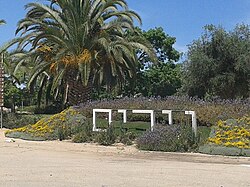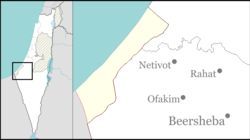Nirim
Nirim
נִירִים نيريم | |
|---|---|
 | |
| Coordinates: 31°20′6″N 34°23′45″E / 31.33500°N 34.39583°E | |
| Country | Israel |
| District | Southern |
| Council | Eshkol |
| Affiliation | Kibbutz Movement |
| Founded | 6 October 1946 |
| Founded by | Hashomer Hatzair members |
| Area | 22,000 dunams (22 km2 or 8 sq mi) |
| Population (2022)[1] | 416 |
| • Density | 19/km2 (49/sq mi) |
| Website | www.nirim.co.il |
Nirim (Hebrew: נִירִים, lit. plowed fields) is a kibbutz in the northwestern Negev in Israel. Located near the border with the Gaza Strip, about 7 kilometres (4.3 mi) east of Khan Yunis, it falls under the jurisdiction of Eshkol Regional Council.[2] In 2022 it had a population of 416.[1]
History
[edit]The kibbutz was established in October 1946 as part of the 11 points in the Negev plan aimed at establishing a Jewish presence in the Negev in order to claim it as part of a future Jewish state.[3] It was named after the Nir brigade of the Hashomer Hatzair youth movement, some of whose members helped establish the kibbutz, and was originally established on a site called "Dangour", where kibbutz Sufa is now.[2] One of the founders was Dan Zur, who became one of Israel's leading landscape architects.[4]


At the outbreak of the 1948 Arab–Israeli War on 15 May 1948, the kibbutz was first Jewish settlement in Israel to be attacked by the Egyptian army, in the Battle of Nirim.[3] It had 39 defenders.[5] During the battle, the Egyptians came within 25 meters of the kibbutz perimeter and eight of the kibbutz defenders were killed, before Egyptians withdrew.[3] All of the houses were destroyed in the attack.[5]

Nirim remained an Israel Defense Forces (IDF) outpost against the Egyptian army throughout the war.[citation needed]
In 1948, the family of Salman Abu Sitta was forcibly expelled from the area, and their land, which was then known as Ma'in Abu Sitta, subsequently used to expand the kibbutz.[6]
After the war, the IDF wanted the site because of its strategic location, while the kibbutzniks wanted to move north, to the line of 200 millimeters of rain a year, so the kibbutz moved some 12 kilometers northeast to its present location,[when?] next to the site of an ancient synagogue at Horvat Maon. During the Mapam split of 1952, Moshe Sneh's supporters were banished from the kibbutz. Until 1956, it was targeted by Fedayeen attacks from the Gaza Strip.[2]
Since 2000, Nirim has been hit by Qassam rockets fired from the Gaza Strip. After Israel's launching of Operation Cast Lead, in January 2009, most of Nirim's members, as well as other villages near the Gaza Strip, were evacuated. Dozens of families from Nirim stayed at kibbutz Mishmar HaEmek in the Jezreel Valley for a month, until the end of the operation.[3] On August 26, 2014, on the last day of Operation Protective Edge, the head of security, Ze'ev "Ze'evik" Etzion and the assistant head of security Shachar Melamed, were killed in a rocket attack. They were both working with a team of electricians and other kibbutz members, attempting to reinstate the electricity to the community after the high voltage tower that supplied electricity to the whole kibbutz was hit by a rocket earlier the same day. The same rocket attack that killed Ze'evik and Shachar, blew off the legs of Gadi Yarkoni, who has since been elected mayor of the Eshkol Regional Council, and currently serving his second term.[citation needed]
October 2023 Hamas-led attack
[edit]Nirim was one of the Israeli villages attacked by Hamas forces in the 2023 Hamas-led attack on Israel. At least five people were killed in the attack and many were injured.[7] Some members of the kibbutz were kidnapped to Gaza. About seven hours after the forces entered the kibbutz, IDF soldiers killed nine Hamas fighters that were still there.[8] The Hamas forces inflicted significant damage upon the kibbutz. In response, a crowdfunding initiative was initiated to support the kibbutz's restoration, amassing over half a million shekels within just a few days.[9]
Economy
[edit]Nirim produces organically grown peanuts, sweet potatoes, turnips, carrots, wheat, barley, avocado and other vegetables, and exports them to Europe. The farmers work the land right up to the Gaza Strip barrier.[3] After Israel's disengagement from Gaza in 2005, the Defense Ministry decided to construct a security strip in the area surrounding Gaza, which was to run through Nirim agricultural territory. Nirim was asked to concede NIS 1 million of its compensation funds.[10]
References
[edit]- ^ a b "Regional Statistics". Israel Central Bureau of Statistics. Retrieved 21 March 2024.
- ^ a b c El'azari, Yuval, ed. (2005). Mapa's concise gazetteer of Israel (in Hebrew). Tel-Aviv: Mapa Publishing. p. 372. ISBN 965-7184-34-7.
- ^ a b c d e Aisenberg, Lydia (16 April 2009). "Feeling Gaza". The Jerusalem Post. Archived from the original on 24 January 2011. Retrieved 24 April 2009.
- ^ Esther Zandberg (13 December 2012). "Israel Prize Laureate for Architecture, Dan Zur, Dies at 86". Haaretz. Retrieved 19 November 2023.
- ^ a b Lavie, Aviv; Moshe Gorali (29 October 2003). "'I saw fit to remove her from the world'". Haaretz. Archived from the original on 20 October 2023. Retrieved 24 April 2009.
{{cite news}}: CS1 maint: bot: original URL status unknown (link) - ^ Uri Davis: In Search of the Abu Sitta sword, Left Curve 32/2008]
- ^ Darwish, Muhammad; Robertson, Nic; Moshtaghian, Artemis; Tal, Amir; Kottasová, Ivana (11 October 2023). "Children found 'butchered' in Israeli kibbutz, IDF says, as defense of Hamas' attacks near border begins to emerge". CNN. Retrieved 21 October 2023.
- ^ Fabian, Emanuel. "9 Hamas terrorists killed in the southern town of Nirim, near Gaza". www.timesofisrael.com. Retrieved 27 November 2023.
- ^ "לחצו כאן כדי לתמוך בקמפיין עזרה לתושבי קיבוץ נירים ששרדו את התופת ממתקפת החמאס" [The campaign helped the residents of the Nirim kibbutz who survived the inferno from the Hamas attack]. my.israelgives.org (in Hebrew). Retrieved 21 October 2023.
- ^ Barshkovsky, Anat (11 September 2005). "Kibbutz: No deal reached for using our land". Ynetnews. Retrieved 24 April 2009.


